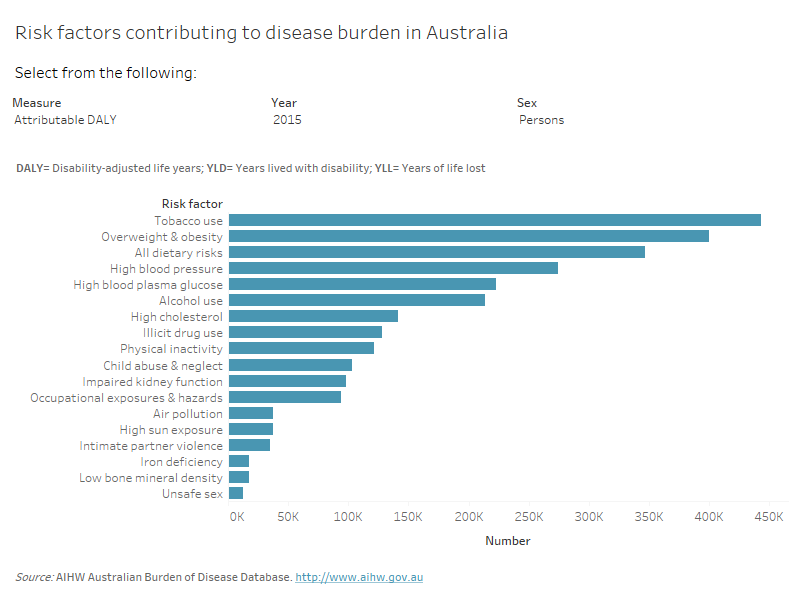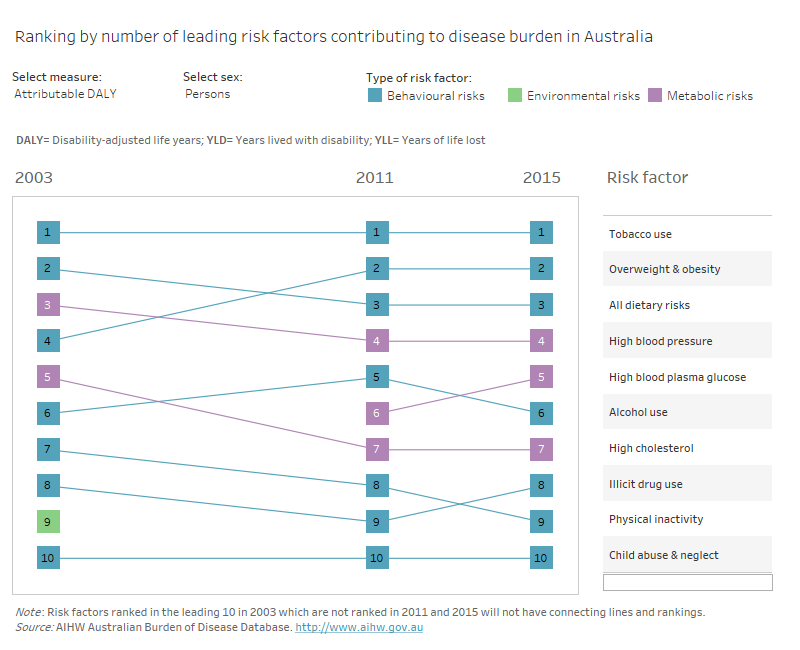Overview
The disease burden due to risk factors is known as attributable burden. It is the amount by which disease burden would be reduced if exposure to the risk factor had been avoided or reduced to the lowest possible exposure. Deaths can also be attributed to risk factors using the same methods.
The Australian Burden of Disease Study 2015 estimated the disease burden and deaths due to 38 risk factor components or exposures (such as cannabis use) that combine into 18 individual risk factors (such as illicit drug use). The risk factors are categorised into 4 groups: behavioural, dietary, metabolic and environmental (Table 1). Risk factors included in this interactive web report are listed below .
This interactive report provides dynamic data displays of attributable burden and attributable deaths in Australia as part of the Australian Burden of Disease Study 2015.
The available estimates include:
- Non-fatal, fatal and total attributable burden estimates by age, sex and linked disease for 2015, and for most risk factors for 2003 and 2011
- Attributable deaths estimates by sex for 2003, 2011 and 2015
- Attributable burden estimates by socioeconomic group for selected risk factors in 2015.
Further information on how to interpret specific measures in the visualisations are shown when hovering over the information icons on available pages.
Risk factors included from the Australian Burden of Disease Study 2015
Behavioural risks
- Alcohol use
- Child abuse & neglect
- Intimate partner violence
- Physical inactivity
- Tobacco use
- Unsafe sex
- Illicit drug use
- Opioid use
- Amphetamine use
- Cocaine use
- Cannabis use
- Other illicit drug use
- Unsafe injecting practices
Metabolic risks
- High blood plasma glucose (including diabetes)
- High blood pressure
- High cholesterol
- Impaired kidney function (including chronic kidney disease)
- Iron deficiency
- Low bone mineral density
- Overweight & obesity
Dietary risks
- Diet high in processed meat
- Diet high in red meat
- Diet high in sodium
- Diet high in sugar sweetened beverages
- Diet low in fish & seafood
- Diet low in fruit
- Diet low in legumes
- Diet low in milk
- Diet low in nuts and seeds
- Diet low in polyunsaturated fat
- Diet low in vegetables
- Diet low in whole grains & high fibre cereals
Environmental risks
Leading risk factors
Around 38% of the burden of disease in Australia in 2015 could have been prevented by reducing exposure to all the modifiable risk factors included in the Australian Burden of Disease Study 2015. This estimate has taken into account the complex pathways and interactions between diseases and risk factors.
The leading five risk factors contributing to total burden were: tobacco use, overweight & obesity, all dietary risks, high blood pressure and high blood plasma glucose (including diabetes).
Tobacco use contributed the greatest amount of fatal burden and deaths in Australia followed by all dietary risks, while overweight & obesity contributed the most non-fatal burden in both males and females.
The burden attributable to most (13 out of 18) risk factors was higher in males than in females; with the exception of child abuse & neglect, low bone mineral density, unsafe sex, iron deficiency and intimate partner violence (only estimated in females).

Changes in leading risk factors over time
Attributable burden was estimated for the years 2003, 2011 and 2015 for selected risk factors. Air pollution was estimated in 2015 only and high blood plasma glucose levels in 2011 and 2015 only, due to lack of suitable data.
For risk factors where data was available over time, the risk factors contributed 37% of the total burden in Australia in 2003 compared with 36% in 2015. This decrease demonstrates a small improvement in the amount of health loss attributable to modifiable risk factors.
Tobacco use, overweight & obesity, all dietary risks and high blood pressure were consistently the leading 4 risk factors in the years 2003, 2011 and 2015. High cholesterol decreased from the 5th highest risk factor in 2003 to the 7th highest in 2015, whereas the reverse was seen in overweight & obesity rankings— moving from the 4th highest risk factor in 2003 to the 2nd highest risk factor in 2015.
There were decreases between 2003 and 2015 in the age-standardised rate of burden attributable to risk factors for high cholesterol by 49%, for high blood pressure by 41%, for dietary risks by 34% and for tobacco use by 24%. Decreases in burden from cardiovascular diseases linked to these risk factors contributed to the decrease in rate of attributable burden.
In males, illicit drug use and occupational exposures & hazards ranked higher (8th and 9th respectively in 2015) compared to females (not in the 10 leading risk factors in 2015).
When looking at non-fatal burden, overweight & obesity and tobacco use were consistently the leading 2 risk factors in the years 2003, 2011 and 2015. High blood glucose ranked 3rd in the years 2011 and 2015, however was not included in the rankings for 2003 due to lack of suitable data.
In males, alcohol use, occupational exposures & hazards and illicit drug use ranked higher for non-fatal burden (3rd, 7th and 8th respectively in 2015) compared with females. Intimate partner violence ranked 6th for non-fatal burden in 2015, however this risk factor was only estimated in females due to lack of suitable data in males.
When looking at the number of deaths attributable to risk factors, tobacco use, dietary risks and high blood pressure consistently contributed the most in Australia across all years, for both males and females.



